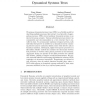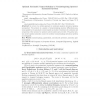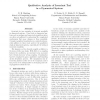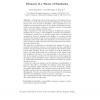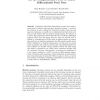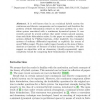103
Voted
UAI
2004
15 years 1 months ago
2004
We propose dynamical systems trees (DSTs) as a flexible model for describing multiple processes that interact via a hierarchy of aggregating processes. DSTs extend nonlinear dynam...
DAGSTUHL
2006
15 years 1 months ago
2006
In this paper we study a class of dynamical systems defined by Pfaffian maps. It is a sub-class of o-minimal dynamical systems which capture rich continuous dynamics and yet can be...
102
click to vote
CSC
2006
15 years 1 months ago
2006
: A review of a uni...ed approach to nonlinear operator dynamical systems is presented. The solution to a system of nonanticipating operator di
118
click to vote
MCU
2007
15 years 1 months ago
2007
We review some results about the computational power of several computational models. Considered models have in common to be related to continuous dynamical systems. 1 Dynamical Sy...
VISUALIZATION
1995
IEEE
15 years 4 months ago
1995
IEEE
Invariant tori are examples of invariant manifolds in dynamical systems. Usual tools in dynamical systems such as analysis and numerical simulations alone are often not sufficient...
116
click to vote
ECAL
1995
Springer
15 years 4 months ago
1995
Springer
Arti cial Life and the more general area of Complex Systems does not have a uni ed theoretical framework although most theoretical work in these areas is based on simulation. This ...
101
click to vote
STACS
2000
Springer
15 years 4 months ago
2000
Springer
We prove that several global properties (global convergence, global asymptotic stability, mortality, and nilpotence) of particular classes of discrete time dynamical systems are un...
127
Voted
HYBRID
2000
Springer
15 years 4 months ago
2000
Springer
Results from classical dynamical systems are generalized to hybrid dynamical systems. The concept of limit set is introduced for hybrid systems and is used to prove new results on...
120
Voted
FORMATS
2006
Springer
15 years 4 months ago
2006
Springer
Abstract. Well-known hierarchies discriminate between the computational power of discrete time and space dynamical systems. A contrario the situation is more confused for dynamical...
95
Voted
CSL
2004
Springer
15 years 4 months ago
2004
Springer
It is well known that in an o-minimal hybrid system the continuous and discrete components can be separated, and therefore the problem of finite bisimulation reduces to the same pr...
